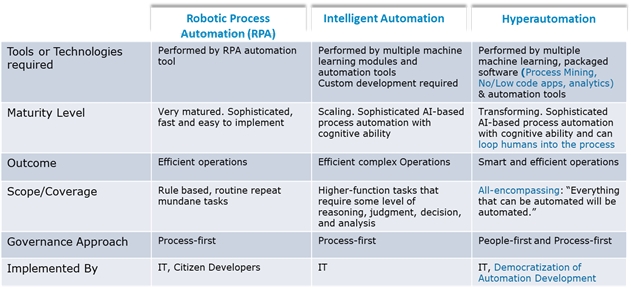How is hyperautomation different from intelligent automation and RPA?
One of the fundamental elements in hyperautomation is empowering business users to automate long-tail tasks. These business users are called citizen developers, and the overall concepts are called the democratization of development. You are democratizing bot development with business users (employees) and your IT teams.
One of the fundamental elements in hyperautomation is empowering business users to automate long-tail tasks. These business users are called citizen developers, and the overall concepts are called the democratization of development. You are democratizing bot development with business users (employees) and your IT teams.
In hyperautomation, adding the extra layer of intelligence and democratizing automation development is key to digital operational excellence and operational resiliency. Therefore, while hyperautomation combines the properties of RPA and intelligent automation (IA), it still is quite distinct in terms of the overall outcomes it provides.
Hyperautomation and intelligent automation are often used interchangeably. RPA is a pretty straightforward concept. I have differentiated among all of them to provide better clarity, but some may rightfully argue that hyperautomation and intelligent automation are the same.

Lets explore these technologies a little more.
Robotic process automation
Robotic process automation (RPA) utilizes bots, a software program to carry out tasks. Typically, routine, repetitive and predictive tasks are relegated to bots that perform them with accuracy and little-to-no human intervention. Businesses implement RPA to automate high volume tasks that were earlier done by humans. Automating such tasks improves employee productivity, since employees can now focus on activities that impact the business. Manufacturing firms have widely used RPA to automate order fulfillment, process purchase orders and generate bills of materials.
Intelligent automation
While RPA automates mundane, rule-based processes and tasks, IA goes one step further and assists humans in decision making. It adds a layer of artificial intelligence technologies like machine learning and natural language processing to augment human decision-making capabilities. IA simulates human thinking and therefore can be utilized to carry out higher function tasks that require some form of judgement and reasoning. For example, retailers can use IA to check and replenish inventory in warehouses, scan products on stores shelves and summon a restock order.
Hyperautomation
Now that we have a clear idea of RPA and IA, let me shed some light on hyperautomation and how it could help companies. Hyperautomation harnesses the power of RPA and IA (including artificial intelligence, machine learning and analytics) to automate complex and critical business processes. The assimilation of these automation elements makes hyperautomation a real digital transformation tool. Hyperautomation can help companies scale their automation programs, transcend organizational barriers and enable cross-process automation. This, by far, is hyperautomation’s most distinguishing factor.
In the following article, we will discuss how hyperautomation can help organizations. Until then, stay tuned!
By Yash Malge, Head of Robotic Process Automation, Digital Transformation Office – North America
Posted on July 01
Topics